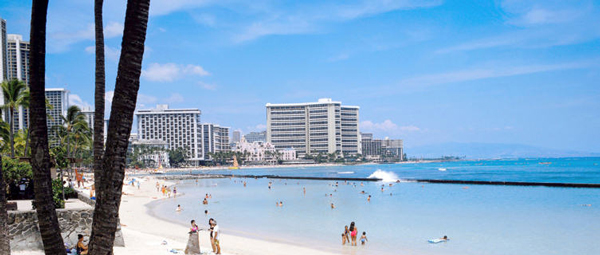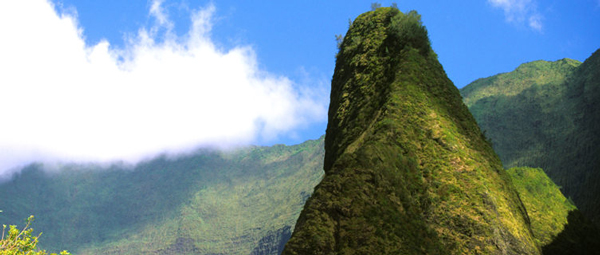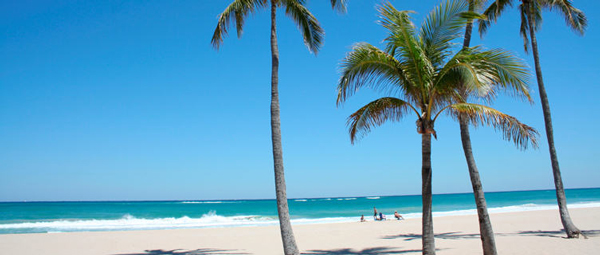Hawaii Travel Guide, Hawaii (Hawaiian: Hawaiʻi, sometimes pronounced ha-VAI-ee by locals) is the 50th state of the United States of America. Situated nearly at the center of the north Pacific Ocean, Hawaii marks the northeast corner of Polynesia. While it was once a major hub for the whaling, sugar and pineapple industries, it is now economically dependent on tourism and the U.S. military. The natural beauty of the islands continues to be one of Hawaii’s greatest assets. Honolulu is the state’s capital, largest city, and cultural hub. Hawaiian and English are the official languages of Hawaii.
Islands
Hawaii is an archipelago of over nineteen distinct volcanic islands located over a geological “hot spot” in the Central Pacific. The Pacific plate on which the islands ride moves to the northwest, so in general the islands are older and smaller (due to erosion) as you move from southeast to northwest. There are eight major islands, six of which are open to tourism.

Hawaii (Hawaiʻi) – almost always called the Big Island to avoid confusion – is the largest of the islands and home to Mauna Kea, Mauna Loa (the largest and one of the most active volcanoes on Earth), Hawaii Volcanoes National Park , coffee and macadamia nut plantations, working ranches, and even green sand beaches. Kailua-Kona is the busiest part of the island on the dry, leeward side, and near the mega-resort Kohala Coast area with nearly zero annual precipitation. The saddle road (quite passable and a must see–despite what rental car companies say) passes between the massive volcanoes and connects Kohala with Hilo, the largest town on the windward side with annual precipitation of more than 300 inches per year. Unlike anywhere else on Earth and definitely worth a look.
Oahu (Oʻahu), nicknamed “the Gathering Place,” is the most populous and developed island. Its southern shore is home to the city of Honolulu, the state capital and largest city; four out of every five kama’aina (Hawaii residents) call it home. It is the governmental and commercial center of the state, and Waikiki Beach is arguably the best known tourist destination in Hawaii. Outside the city are pineapple fields, and the North Shore of Oahu, which is known each winter as the home of some of the largest waves in the world. The USS Arizona National Memorial at Pearl Harbor is also very popular visitor destination.
Maui is the second largest island in the chain and is home to 10,023 foot (3,055 m) tall volcanic mountain crater of Haleakala. It is nicknamed “the Valley Isle” for the narrow plain between Haleakala and the West Maui mountains. On the west side of the island are the resort areas of Lahaina, Kaanapali and Kapalua, while the south side is home to Kihei, and Wailea. On the east side is the tiny village of Hana, reached by one of the most winding and beautiful roads in the world.
Kauai (Kauaʻi), the “Garden Isle,” is home to several natural wonders, such as the Wailua River, Waimea Canyon, and the Na Pali Coast. Mount Waialeale is known as one of the rainiest spots in the world.
Molokai (Molokaʻi), the “Friendly Isle,” is one of the least developed islands in the chain. It is home to Kalaupapa, the leper colony on Molokai’s north shore that was the home of Father Damien.
Lanai (Lānaʻi) was at one time completely owned by Dole Foods and was the largest pineapple plantation in the world; it is now home to several exclusive resorts.
Niihau (Niʻihau) is a privately owned island with an entirely Native Hawaiian population. Until very recently, the island was off limits to all but family members and invited guests of the owners. Tourism to the island is limited to helicopter, ATV, and hunting excursions originating on Kauai.
Kahoolawe (Kahoʻolawe), which was once a former U.S. Navy bombing range, remains uninhabited. Efforts are being made to rehabilitate the island, but cleanup efforts continue.

History
Polynesians migrated to, and established communities on, the islands of Hawaii before the arrival of Captain James Cook in 1778, who is widely credited as the first European visitor to the islands. At that time, each island was a separate kingdom. With the support of western advisors and weapons, Kamehameha I of the island of Hawaii conquered all the islands except Kauai, which acquiesced to his rule in 1810.
After Kamehameha II abolished the kapu (taboo) system, American missionaries came to the islands to spread Christianity, and quickly began establishing imperial enterprise and amassing political power on the islands. Their children would later become successful businessmen in the Islands and still own entire islands to this day. Pineapple and sugar cane plantations were established, and workers from other countries (in particular Japan, the Philippines, China, and Korea) were imported as contract laborers. Later, their descendants would also become established as successful professionals.

The Hawaiian monarchy was overthrown in 1893 by a group of American businessmen. While the U.S. administration at the time refused to annex the former sovereign nation, in 1898 the United States did annex the islands, which became a territory in 1900, and a state of the United States in 1959.
Hawaii also became an important outpost for the U.S. military through the 20th century, and Pearl Harbor was the site of the Japanese attack on December 7, 1941, that resulted in the U.S. joining World War II. Today, the military maintains its presence here, with several major military bases on the island of Oahu alone; Pearl Harbor remains the headquarters of the U.S. Pacific Fleet.
Over the years, many major retail chains have expanded their presence in Hawaii, making the Islands look more and more like the continental United States, often at the expense of local businesses. Nevertheless, Hawaii remains culturally vibrant. Its population, descended from the Native Hawaiians, the original plantation workers, and more recent arrivals, and in which no one group has a majority, is often cited as an example of multiculturalism at its best. There is a strong commitment to perpetuating native Hawaiian cultural traditions, as well as the cultural heritage of Hawaii’s many immigrant communities from the Pacific, Asia and Europe. And certainly the environment is conducive to longevity…Hawaii has the longest predicted life expectancies of any U.S. state.

Weather
Depending on where you’re located in Hawaii, the weather can be very different over even short distances. On the same day, on Oahu you might find sun over the beaches in Waikiki and rain only a few miles away in Manoa Valley.
Although the islands receive abundant amounts of both sunshine and rain, rain is more likely on the north and east sides of the islands, which face the prevailing northeasterly tradewinds (the “windward” side of the island), as well as the mountain peaks and valleys. The moist tropical air carried by the tradewinds is forced upward by the mountains, resulting in clouds and rain. Rain is less likely on the coastal areas of the “leeward” sides (the south and west sides) of the islands.
Although there are no true “seasons” in the islands in the same sense as the rest of the U.S., the climate does go through annual cycles based on rainfall. The “wet” season in Hawaii (cooler temperatures and more rainfall) runs roughly from October to March, and the “dry” season (warmer temperatures and less rainfall) from April to September. There is therefore a higher probability of rain if you visit during the peak of tourist season in late December or January.
Hurricane season in the islands runs from June to November. Although Hawaii’s relative isolation means that it is affected only rarely by tropical cyclones, a destructive storm will occasionally hit the Islands, such as Hurricanes Iwa and Iniki hitting Kauai in 1982 and 1992 respectively.
Overall, Hawaii is warm and balmy — when you step out of the plane you’ll immediately notice that the air is soft and humid — and during the summer months the tradewinds provide a pleasant breeze. Daytime temperatures generally range from the low 80s (27°C) in “winter” to the high 80s (31°C) in “summer”. Very rarely does the air temperature exceed 90°F (32°C) even in the hottest part of summer; however, the humidity will make it feel as if it were a few degrees hotter. Ocean temperatures range between 77°F (25°C) degrees in the winter to 82°F (28°C) in the summer. There is usually no more than a 20°F (12°C) difference between daytime high and nighttime low temperatures.
Consequently, besides your driver’s license, credit card, camera, binoculars, and other essentials, it’s best to keep your clothes to a minimum… a jacket, sweater, one or two pair of washable slacks/shorts, walking shoes, sandals and swim gear. Sunscreen is essential since Hawaii’s close proximity to the Equator translates into very strong sun radiation. The suitcase space you save can be used to fill up on island purchases.

Get in
Foreign travelers entering Hawaii directly from another country are subject to the same entry requirements as for the United States in general. See the Get in section of the United States article.
As Hawaii is one of the 50 United States, flights to Hawaii from the U.S. Mainland (that is, all of the U.S. outside of the state) are considered domestic flights. Therefore, it is not necessary for U.S. citizens or legal immigrants to show a passport (or any documentation of U.S. citizenship or immigration status) when entering Hawaii from the U.S. Mainland. It is also not necessary for foreign visitors arriving from the U.S. Mainland to show passports or visas (U.S. entry formalities are done at the port of entry).

You will, however, be asked to fill out a written agricultural declaration while aboard your flight to Hawaii. This declaration is required by the U.S. and Hawaii state departments of agriculture to prevent harmful plant pests and diseases from coming into Hawaii. Any fresh fruits, vegetables, flowers, and the like need to be declared and inspected by Department of Agriculture personnel at your port of arrival; some items may be prohibited from entering Hawaii at all. Penalties for non-compliance are stiff. Avoid bringing such items with you if at all possible. It’s not worth the hassle. (On the reverse side of this declaration is a Hawaii Tourism Authority questionnaire that asks for information about your stay. You are encouraged but not required to complete this questionnaire.) Be sure to bring a pen on your inbound flight to Hawaii.
When leaving Hawaii for the U.S. Mainland, all baggage must be inspected by U.S. Department of Agriculture inspectors at the airport. Be advised that fresh fruits (with the exception of pineapples and treated papayas) are prohibited from leaving the islands to prevent the spread of fruit flies. Consult the U.S. Department of Agriculture for more details. Bags are inspected by X-ray, so depending on the airport you leave from and the airline, be prepared to submit to as many as three checkpoints on the way to your Mainland flight: having your checked bags X-rayed in the ticket lobby, the TSA security checkpoint, and perhaps a separate agricultural inspection for your carry-on bags on the way to your gate.
Hawaii does not observe Daylight Saving Time. For reference, Hawaii is two time zones behind the U.S. West Coast, thereby accounting for a three hour time difference during DST. Arizona, which also does not observe DST save for the Navajo Reservation, is always three hours ahead of Hawaii year-round.
By plane
Most flights from the mainland US and almost all international flights land in Honolulu on the island of Oahu. From here, passengers destined for a Neighbor Island will connect to an interisland flight (see By Plane in Get Around below). Direct service from the mainland is also available to Kahului on Maui, Kona and Hilo on the Big Island, and Lihue on Kauai as well.
Depending on the airline, nonstop flights to Honolulu leave from most major gateway airports on the West Coast (as well as some smaller ones), as well as many major airports in the Midwest and East Coast. The flight from Los Angeles or San Francisco takes about 5 hours, comparable to a flight between the West and East Coasts. Thus, a flight from New York can take about 10.5 hours. Foreign carriers such as Korean, Philippine Airlines, Asiana, Japan Airlines, etc. cannot sell tickets just to Hawaii from the mainland but they can if originating from outside the United States or to passengers who are ticketed for onward travel (usually to Asia, Australia, New Zealand or elsewhere in the South Pacific) from the mainland as a stopover for free or for an extra fare.
The U.S. military occupies a large space of Hawaii. Today, there are 11 active military bases in Oahu – Bellows Air Force Station, Hickam AFB, MCB Hawaii, and NAS Pearl Harbor are the island’s main military operations. Due to the island’s remote pacific location, military flights to Hawaii are the only option for many. Military flights to Hawaii typically operate from San Diego to Honolulu. Space-A flights from San Diego are available to military personnel and dependents as well as military travel financing.
Crime
Theft is a big problem in cities as well as beaches and parks. If you are camping on a beach, keep bags locked in a car (but don’t assume that they are safe in the trunk, especially if you are driving a rental) and keep valuables in a hidden money belt. Although Hawaii is generally considered relatively safe, it does have some violent crime, especially in Honolulu. Consequently, women should not walk alone in unlit areas. Although Honolulu has one of the lowest violent crime rates of metro areas in the U.S., use your common sense. Stay smart and act as if you were in your own home city: lock doors, lock cars, and don’t leave valuables lying around.
In general, do not bring anything to the beach that you will not use. If you absolutely must, keep valuables to a minimum (such as money), and bring a friend. If you are using a rental car and do not have valuables in it, leaving the window open can ward off window damage from break-ins. Purchasing local bumper stickers and placing them on your car can also ward off would-be thieves, who may mistake your car for being a local’s


0 Comments